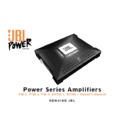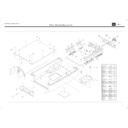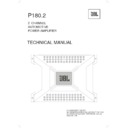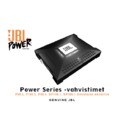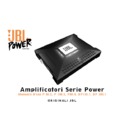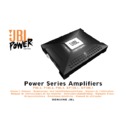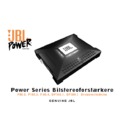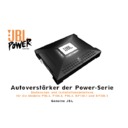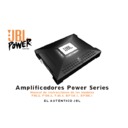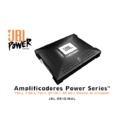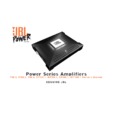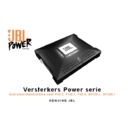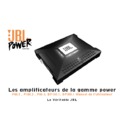JBL P 180.2 (serv.man18) User Manual / Operation Manual ▷ View online
• Before drilling or cutting holes,
use a utility knife to remove
unwanted fabric or vinyl to keep
material from snagging in a drill
bit.
unwanted fabric or vinyl to keep
material from snagging in a drill
bit.
• When routing cables, keep input-
signal cables away from power
cables and speaker wires.
cables and speaker wires.
• When making connections, make
certain they are secure and proper-
ly insulated.
ly insulated.
• If the amplifier’s fuse must be
replaced, use only the same type
and rating as that of the original.
Do not substitute another kind.
and rating as that of the original.
Do not substitute another kind.
2
your particular vehicle. If you feel
you lack the necessary tools or
experience, ask your authorized JBL
car-audio dealer about professional
installation options.
you lack the necessary tools or
experience, ask your authorized JBL
car-audio dealer about professional
installation options.
Installation Warnings and Tips
• Always wear protective eyewear
when using tools.
• Turn off all audio systems and
other electrical devices before you
start. Disconnect the (–) negative
lead from your vehicle’s battery.
start. Disconnect the (–) negative
lead from your vehicle’s battery.
• Check clearances on both sides of
a planned mounting surface before
drilling any holes or installing any
screws. Remember that the screws
can extend behind the surface.
drilling any holes or installing any
screws. Remember that the screws
can extend behind the surface.
• At the installation sites, locate and
make a note of all fuel lines,
hydraulic brake lines, vacuum lines
and electrical wiring. Use extreme
caution when cutting or drilling in
and around these areas.
hydraulic brake lines, vacuum lines
and electrical wiring. Use extreme
caution when cutting or drilling in
and around these areas.
Thank you
for purchasing a JBL
Power Series™ amplifier. In order
that we may better serve you should
you require warranty service for
your new amplifier, please retain
your original purchase receipt and
return the enclosed warranty regis-
tration card.
Warning: Playing loud music in an
automobile can permanently dam-
age your hearing as well as hinder
your ability to hear traffic. We rec-
ommend listening at low levels
while driving your car. JBL accepts
no liability for hearing loss, bodily
injury or property damage resulting
from use or misuse of this product.
Important: Installation of automo-
tive stereo components can require
extensive experience in performing
a variety of mechanical and electri-
cal procedures. Although these
instructions explain, in a general
sense, how to install Power Series
amplifiers, they may not show
the exact installation methods for
that we may better serve you should
you require warranty service for
your new amplifier, please retain
your original purchase receipt and
return the enclosed warranty regis-
tration card.
Warning: Playing loud music in an
automobile can permanently dam-
age your hearing as well as hinder
your ability to hear traffic. We rec-
ommend listening at low levels
while driving your car. JBL accepts
no liability for hearing loss, bodily
injury or property damage resulting
from use or misuse of this product.
Important: Installation of automo-
tive stereo components can require
extensive experience in performing
a variety of mechanical and electri-
cal procedures. Although these
instructions explain, in a general
sense, how to install Power Series
amplifiers, they may not show
the exact installation methods for
Choosing a Location and Mounting
the Amplifier
the Amplifier
Amplifiers need air to stay cool.
Suitable locations are under a seat
(provided the amplifier doesn’t
interfere with the seat adjustment
mechanism), in the trunk or in any
other location which provides
enough air for the amp to cool itself.
Do not mount the amplifier with the
heat sink facing downward, as this
makes convection cooling of the
amplifier impossible.
Mount the amplifier so that it is not
damaged by the feet of back-seat
passengers or shifting cargo in the
trunk. Mount the amplifier so that it
remains dry – never mount an
amplifier outside the car or in the
engine compartment.
Using the amplifier as a template,
mark the location of the mounting
holes on the mounting surface, drill
pilot holes, and attach the amplifier
to the mounting surface with
screws. Make sure the amplifier is
mounted securely.
Suitable locations are under a seat
(provided the amplifier doesn’t
interfere with the seat adjustment
mechanism), in the trunk or in any
other location which provides
enough air for the amp to cool itself.
Do not mount the amplifier with the
heat sink facing downward, as this
makes convection cooling of the
amplifier impossible.
Mount the amplifier so that it is not
damaged by the feet of back-seat
passengers or shifting cargo in the
trunk. Mount the amplifier so that it
remains dry – never mount an
amplifier outside the car or in the
engine compartment.
Using the amplifier as a template,
mark the location of the mounting
holes on the mounting surface, drill
pilot holes, and attach the amplifier
to the mounting surface with
screws. Make sure the amplifier is
mounted securely.
3
Figure 1
Figure 2
Figure 3
P80.4
BP150.1, BP300.1
Note: Drawing is provided only for connector, control and fuse location.
Please see “Specifications” for fuse requirements.
Please see “Specifications” for fuse requirements.
Note: Drawing is provided only for connector, control and fuse location.
Please see “Specifications” for fuse requirements.
Please see “Specifications” for fuse requirements.
HIGH LEVEL
HIGH LEVEL
R
L
R
L
FRONT
REAR
+ R – – L +
+ R – – L +
LEVEL FREQ FREQ LEVEL
X-OVER INPUT MODE X-OVER
4V 250mV 32Hz 320Hz 32Hz 320Hz 4V 250mV
FLAT HP LP ST MD ST MD FLAT HP LP
POWER
BRIDGED
SPEAKER OUTPUTS
FUSES 20A x 2
FRONT
REAR
+BATT REM GND
–
L
+
–
R
+
–
+
SPEAKER OUTPUTS
FUSES 40A x 3
POWER
– +
– +
+ BATT REM GND
R
R
L
L
HIGH LEVEL
FRONT INPUTS
REAR INPUTS
HIGH LEVEL
INPUT
LEVEL
LEVEL
LPF
FREQ
BASS
BOOST
R L
R L
+ –
– +
– +
+ –
4V 250mV
32Hz 320Hz
0dB +6dB
P80.2, P180.2
Note: Drawing is provided only for connector, control and fuse location.
Please see “Specifications” for fuse requirements.
BRIDGED
SPEAKER OUTPUTS
POWER
FUSES 20A x 2
— +
— +
L
+ —
R
+BATT REM GND
INPUT
LEVEL
LEVEL
INPUT MODE
X-OVER
HIGH LEVEL
INPUTS
4V 250mV
ST MD
FLAT HP LP
32Hz320Hz
FREQ
R
L
+ R – – L +
4
FREQUENCY
INDUCTOR
CAPACITOR
Crossover
6dB/oct. LP
6dB/oct. HP
(4-ohm)
(4-ohm)
75Hz
8.0mH
530µF
100Hz
6.4mH
400µF
125Hz
5.0mH
318µF
150Hz
4.2mH
265µF
175Hz
3.6mH
227µF
200Hz
3.2mH
198µF
Wiring the Power Connections
Refer to Figures 1–3 for connector
locations. All the Power Series
amplifiers will accept up to 4-gauge
power and ground wire.
For power, remote and ground con-
nections, strip off one end of each
jacket to reveal bare wire for inser-
tion into the connectors. Connect a
wire from the GND connector on the
amplifier to the nearest bare-metal
chassis component; scrape away
the paint to ensure good conductivi-
ty. Next, connect a wire between the
BATT terminal on the amplifier and
the POS(+) terminal of the vehicle’s
battery. Pass the wire through a fac-
tory-installed grommet in the fire-
wall, or install a grommet if a facto-
ry grommet is not available.
Connect a wire between the REM
terminal of the amplifier and the
“remote out” or power-antenna lead
on the vehicle’s radio.
locations. All the Power Series
amplifiers will accept up to 4-gauge
power and ground wire.
For power, remote and ground con-
nections, strip off one end of each
jacket to reveal bare wire for inser-
tion into the connectors. Connect a
wire from the GND connector on the
amplifier to the nearest bare-metal
chassis component; scrape away
the paint to ensure good conductivi-
ty. Next, connect a wire between the
BATT terminal on the amplifier and
the POS(+) terminal of the vehicle’s
battery. Pass the wire through a fac-
tory-installed grommet in the fire-
wall, or install a grommet if a facto-
ry grommet is not available.
Connect a wire between the REM
terminal of the amplifier and the
“remote out” or power-antenna lead
on the vehicle’s radio.
Wiring the Speaker-Output
Connections
Connections
P80.2, P180.2, P80.4
All the Power Series amplifiers will
accept up to 8-gauge speaker wire.
Connect the speakers, observing
proper polarity, to the speaker-out-
put connector. The total impedance
of the speaker system connected to
the amplifier when the amplifier is
driven in stereo must be at least two
ohms.
If you are bridging the amplifier,
connect the speaker wires to the ter-
minals marked “bridged,” observing
proper polarity. The total impedance
of the speaker system connected to
the amplifier must be at least four
ohms in bridged mode.
All the Power Series amplifiers will
accept up to 8-gauge speaker wire.
Connect the speakers, observing
proper polarity, to the speaker-out-
put connector. The total impedance
of the speaker system connected to
the amplifier when the amplifier is
driven in stereo must be at least two
ohms.
If you are bridging the amplifier,
connect the speaker wires to the ter-
minals marked “bridged,” observing
proper polarity. The total impedance
of the speaker system connected to
the amplifier must be at least four
ohms in bridged mode.
If you are running the amp in Tri-
Mode (stereo and mono simultane-
ously), connect the satellite speakers
to the speaker connector as you
would a pair of stereo speakers.
Connect the subwoofer to the termi-
nals marked “bridged” Refer to the
chart above to determine the capaci-
tor and inductor values you’ll need
to route bass signals to the woofer,
and the midrange and high frequen-
cies to the satellite speakers. These
passive crossover components will
also ensure that the impedance of
the speaker system doesn’t drop
below two ohms.
Mode (stereo and mono simultane-
ously), connect the satellite speakers
to the speaker connector as you
would a pair of stereo speakers.
Connect the subwoofer to the termi-
nals marked “bridged” Refer to the
chart above to determine the capaci-
tor and inductor values you’ll need
to route bass signals to the woofer,
and the midrange and high frequen-
cies to the satellite speakers. These
passive crossover components will
also ensure that the impedance of
the speaker system doesn’t drop
below two ohms.
BP150.1, BP300.1
Connect the woofers to the amplifi-
er, observing proper polarity.
Although these amplifiers have a
single channel, duplicate positive
and negative connectors are provid-
ed to facilitate the connection of
multiple woofers.
The total impedance of the speaker
system connected to a BP Series
amplifier must be at least 1 ohm.
Connect the woofers to the amplifi-
er, observing proper polarity.
Although these amplifiers have a
single channel, duplicate positive
and negative connectors are provid-
ed to facilitate the connection of
multiple woofers.
The total impedance of the speaker
system connected to a BP Series
amplifier must be at least 1 ohm.
5
Setting Input Level
Initially, turn the input-sensitivity
LEVEL control to its maximum
(counter-clockwise) position. Turn
on the source unit and increase the
volume control until it is approxi-
mately three-quarters of maximum-
output level. Slowly increase the
input LEVEL control (clockwise)
while listening to the quality of the
reproduced sound. When you hear
distortion on the music peaks, turn
the LEVEL control back slightly. This
is the maximum undistorted output
level of your system. Turning the
LEVEL control up farther WILL NOT
INCREASE THE OUTPUT POWER
OF YOUR AMPLIFIER! It will only
decrease the amount of volume-
control rotation before the amp is at
full-output power. It will also
increase the amount of extraneous
noise present in your system.
LEVEL control to its maximum
(counter-clockwise) position. Turn
on the source unit and increase the
volume control until it is approxi-
mately three-quarters of maximum-
output level. Slowly increase the
input LEVEL control (clockwise)
while listening to the quality of the
reproduced sound. When you hear
distortion on the music peaks, turn
the LEVEL control back slightly. This
is the maximum undistorted output
level of your system. Turning the
LEVEL control up farther WILL NOT
INCREASE THE OUTPUT POWER
OF YOUR AMPLIFIER! It will only
decrease the amount of volume-
control rotation before the amp is at
full-output power. It will also
increase the amount of extraneous
noise present in your system.
Wiring the Input-Signal
Connections
Connections
Connect a pair of signal cables with
RCA-type ends between the connec-
tors on the amplifier and the RCA-
type signal connectors on the
source unit. If your radio has only
speaker-level outputs, you should
connect them to the speaker-level
input connectors, observing proper
polarity. When using the speaker-
level inputs, it is not necessary to
connect a wire between the
“remote” terminal of the amplifier
and the “remote” lead from the
source unit. The speaker-level
inputs will sense voltage on the
speaker outputs and turn the ampli-
fier on automatically.
If you are installing a P80.4 amplifier
and your source unit has only one
pair of RCA-type output connectors
and a pair of speaker-level outputs,
you may connect the RCA outputs
to a pair of amplifier input channels
(front or rear), and the speaker-level
outputs to the other pair of amplifier
input channels.
RCA-type ends between the connec-
tors on the amplifier and the RCA-
type signal connectors on the
source unit. If your radio has only
speaker-level outputs, you should
connect them to the speaker-level
input connectors, observing proper
polarity. When using the speaker-
level inputs, it is not necessary to
connect a wire between the
“remote” terminal of the amplifier
and the “remote” lead from the
source unit. The speaker-level
inputs will sense voltage on the
speaker outputs and turn the ampli-
fier on automatically.
If you are installing a P80.4 amplifier
and your source unit has only one
pair of RCA-type output connectors
and a pair of speaker-level outputs,
you may connect the RCA outputs
to a pair of amplifier input channels
(front or rear), and the speaker-level
outputs to the other pair of amplifier
input channels.
System Setup and Adjustment
Refer to figures 1–6 for location of
adjustment switches and controls.
Electronic Crossover and Bass Boost
P80.2, P80.4, P180.2
The electronic crossover can be
selected as a 12dB/oct. high-pass fil-
ter (HPF) 12dB/oct. low-pass filter
(LPF) or it can be defeated (FLAT).
The crossover frequency can be set
at any frequency between 32Hz and
320Hz.
BP150.1, BP300.1
These amplifiers are designed to
drive subwoofers. Consequently, the
electronic crossover is a 12dB/oct.
low-pass filter which can be set at
any frequency between 32Hz and
320Hz.
The bass boost control will provide
up to 6dB of boost at 50Hz.
adjustment switches and controls.
Electronic Crossover and Bass Boost
P80.2, P80.4, P180.2
The electronic crossover can be
selected as a 12dB/oct. high-pass fil-
ter (HPF) 12dB/oct. low-pass filter
(LPF) or it can be defeated (FLAT).
The crossover frequency can be set
at any frequency between 32Hz and
320Hz.
BP150.1, BP300.1
These amplifiers are designed to
drive subwoofers. Consequently, the
electronic crossover is a 12dB/oct.
low-pass filter which can be set at
any frequency between 32Hz and
320Hz.
The bass boost control will provide
up to 6dB of boost at 50Hz.
The BP150.1 and BP300.1 are
designed to provide constant bass
regardless of the position of the
source unit’s front-to-rear fader posi-
tion. Use of this feature requires that
all four inputs are connected to the
source unit as labeled on the ampli-
fier (front, rear, right and left). If your
source unit has only one pair of
RCA-type output connectors and a
pair of speaker-level outputs, you
may connect the RCA outputs to a
pair of amplifier input channels
(front or rear), and the speaker level
outputs to the other pair of amplifier
input channels. If nonfading bass is
not important in your system, con-
nect a pair of inputs, either speaker-
level or RCA-type, to either the front
or rear input connectors on the
amplifier.
designed to provide constant bass
regardless of the position of the
source unit’s front-to-rear fader posi-
tion. Use of this feature requires that
all four inputs are connected to the
source unit as labeled on the ampli-
fier (front, rear, right and left). If your
source unit has only one pair of
RCA-type output connectors and a
pair of speaker-level outputs, you
may connect the RCA outputs to a
pair of amplifier input channels
(front or rear), and the speaker level
outputs to the other pair of amplifier
input channels. If nonfading bass is
not important in your system, con-
nect a pair of inputs, either speaker-
level or RCA-type, to either the front
or rear input connectors on the
amplifier.
Display

